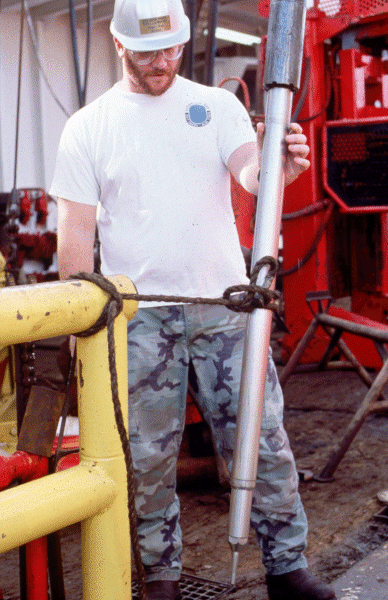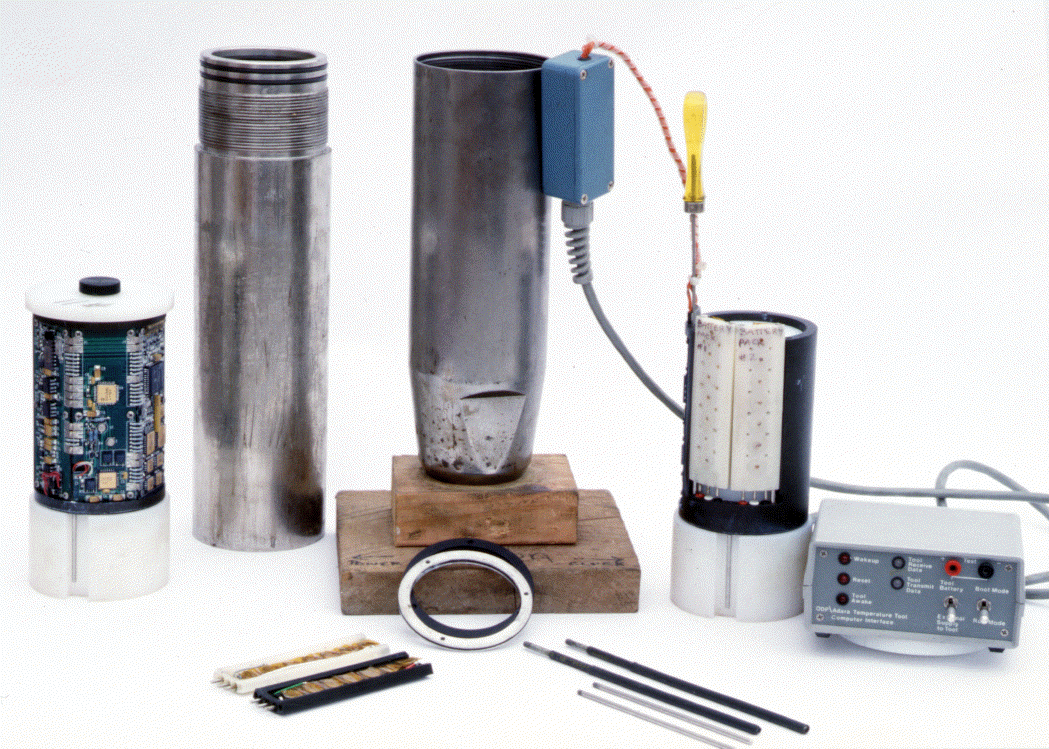

Downhole Measurements
Drill String Tools
Formation Temperature Measurements
 Two types of ODP tools are routinely available for measuring temperatures in sediment and in open hole: the WSTP mentioned before and miniature instruments deployed within special APC cutting shoes.
These tools are normally used separately to obtain single measurements of temperature at discrete depths during a sequence of coring a hole through sediments.
In addition, they can be configured together for simultaneous use without coring.
Either tool or the combination can be washed and pushed through soft sediments or run into open hole, to measure temperatures at multiple depths during a single lowering.
Two types of ODP tools are routinely available for measuring temperatures in sediment and in open hole: the WSTP mentioned before and miniature instruments deployed within special APC cutting shoes.
These tools are normally used separately to obtain single measurements of temperature at discrete depths during a sequence of coring a hole through sediments.
In addition, they can be configured together for simultaneous use without coring.
Either tool or the combination can be washed and pushed through soft sediments or run into open hole, to measure temperatures at multiple depths during a single lowering.
The first generation APC temperature recorders were developed bt R. Von Herzen and colleagues during the last several years of the Deep Sea Drilling Program (DSDP); ODP purchased 10 new instruments designed and built by Adara, a Canadian geotechnical firm. Like its predecessor, the new device monitors the temperature of a single sensor within the APC cutting shoe. The tool contains its own microprocessor, which is programmed to cycle through a series of sleeping and sampling periods. On penetration, the coring shoe must be held in the sediments for 10-15 minutes to obtain enough data to allow extrapolation beyond the thermal distrubance of insertion to in situ temperature. The APC tool is relatively easy to operate, and with sufficient personel can be run on successive cores in an APC hole. The tool is limited to depths where the force required is within safe limits (usually less than 80k-100k lbs). The pullout force is generally greater when the APC temperature tool is run, compared to when an ordinary APC shoe is run, because leaving the core barrel in the bottom for several minutes for the temperature measurement allows sediments to become packed in around the barrel. In practice, this pullout limit is often reached within the upper 100-150 m of sediment below the seafloor.
 In contrast, the WSTP has been run to depths greater than 400 mbsf, but it may require several hours per run on the coring line between cores.
The WSTP data logger contains no microprocessor, and instead continuously samples at a fixed time interval the resistance of one or more thermistors mounted in a cylindrical probe.
Adara is currently developing a new data logger similar in function to the APC tool, containing its own microprocessor.
The WSTP is attached to the front end of a special core barrel, which functions as a pressure case for the electronics, batteries, data logger, and hydrolics, and is lowered down the drill string and pushed into the sediments.
Again, the probe must be held in place for 10-15 minutes to obtain enough data to allow extrapolation to in situ temperature.
In contrast, the WSTP has been run to depths greater than 400 mbsf, but it may require several hours per run on the coring line between cores.
The WSTP data logger contains no microprocessor, and instead continuously samples at a fixed time interval the resistance of one or more thermistors mounted in a cylindrical probe.
Adara is currently developing a new data logger similar in function to the APC tool, containing its own microprocessor.
The WSTP is attached to the front end of a special core barrel, which functions as a pressure case for the electronics, batteries, data logger, and hydrolics, and is lowered down the drill string and pushed into the sediments.
Again, the probe must be held in place for 10-15 minutes to obtain enough data to allow extrapolation to in situ temperature.
WSTP Temperature Measurements
Most of the tools used to measure temperatures during the early stages of DSDP were similar in concept to the present WSTP, which also incorporates a fluid sampler.
Yokata et al. (1980) and Uyeda and Horai (1982) described the temperature recorder for the first push-in tool, which they developed before DSDP Leg 60.
In combination with the case, batteries, bulkhead, and the temperature probe itself, this tool was known during DSDP and early ODP as the "Uyeda probe" or "Tokyo T-probe".
When combined with an early generation of the Barnes pore-fluid sampler, the resulting temperature and fluid-sampling tool was called the Barnes-Uyeda probe.
In its latest iteration, we refer to this tool as the WSTP.
Both the Uyeda tool and the WSTP employ battery-powered recorders with electronic memories to monitor the resistance of one or more thermistors in a probe that protrudes about 1 m ahead of the bit.
See also ODP Technical Note 10
APC/Adara Temperature Tool
APC tool design and components
 Like the original Von Herzen instrument, the Adara temperature tool (APC tool) is designed to measure sediment temperatures as a piston core is taken.
Each tool comprises a series of circuit boards, battery packs, a temperature sensor, and assorted hardware.
The programmable recorder and battery packs are built into a cylindrical frame, designed to fit in the cutting shoe of the advanced hydrolic piston corer.
At the base of the APC tool frame are two stainless-steel prongs which fit into holes at the bottom of the annular cavity in the cutting shoe.
These prongs help to stabilize the instrument in the cavity, and one of the prongs also contains a platinum resistance temperature device (RTD) which is used to monitor formation temperature during a station.
The wall thickness of the cutting shoe outside the annular cylinder is about 1.5 cm, giving an effective time constant of roughly 2-3 minutes in sediments.
Thus the APC must be held in place for at least 10 minutes to record enough data to reliably extrapolate to in situ sediment temperature.
Like the original Von Herzen instrument, the Adara temperature tool (APC tool) is designed to measure sediment temperatures as a piston core is taken.
Each tool comprises a series of circuit boards, battery packs, a temperature sensor, and assorted hardware.
The programmable recorder and battery packs are built into a cylindrical frame, designed to fit in the cutting shoe of the advanced hydrolic piston corer.
At the base of the APC tool frame are two stainless-steel prongs which fit into holes at the bottom of the annular cavity in the cutting shoe.
These prongs help to stabilize the instrument in the cavity, and one of the prongs also contains a platinum resistance temperature device (RTD) which is used to monitor formation temperature during a station.
The wall thickness of the cutting shoe outside the annular cylinder is about 1.5 cm, giving an effective time constant of roughly 2-3 minutes in sediments.
Thus the APC must be held in place for at least 10 minutes to record enough data to reliably extrapolate to in situ sediment temperature.
The APC tool is run with two battery packs, each of which contains seven ordinary "camera" batteries. A diode has been added to allow the instruments to draw power from both batteries, which helps increase overall battery life and reduces the chances of running out of power during a station. In contrast to the WSTP, data storage in the APC tool recorder is nonvolitile, meaning that previously collected data are retained in memory even if power is lost during a station. The APC tools are calibrated over a temperature range of -20 to 100°C and will operate at temperatures up to 125°C.
See also ODP Technical Note 10
Developemental Tools
The Ocean Drilling Program currently has at its disposal the Davis-Villinger Temperature Probe (DVTP) (Fig. 1) for taking in situ temperature measurements 1.1 meters ahead of the bit. Temperatures are recorded at 1 and 11 cm above the tip of the probe. The combination of the dual temperature records and accelerometer data provides valuable information about disturbances that may affect the quality of measurements. Long battery life, and memory access via an external communications port, allow relatively service-free operation for the full duration of typical drilling legs. Temperature resolution varies over the 110 K measurement range, from nominally 1 mK from -5 to 20°C, to about 10 mK at 105°C. The small (8 mm) diameter of the probe tip allows allows rapid thermal equilibration after penetration. The shallow (2.5°), continuous taper of the lower part of the probe serves to reduce the tendency of the formation to be cracked when the tool is pushed into the formation. It is sufficiently robust, however, to survive penetration into highly consolidated sediment and occasional contact with igneous rock. The tool was used for a total of 44 bottom-hole temperature measurements between 38 and 573 meters below seafloor (mbsf) during Leg 168, as well as for several logging runs in open holes. Davis et al. anticipate adding a port in the tip to permit measurement of formation fluid pressure, and to enhance the utility of the tool for logging temperature profiles in open holes.